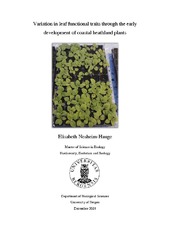| dc.contributor.author | Nesheim-Hauge, Elisabeth | |
| dc.date.accessioned | 2019-01-21T16:32:51Z | |
| dc.date.available | 2019-01-21T16:32:51Z | |
| dc.date.issued | 2018-12 | |
| dc.date.submitted | 2019-01-15T23:00:02Z | |
| dc.identifier.uri | http://hdl.handle.net/1956/18940 | |
| dc.description.abstract | Seedling recruitment provides a mechanism for re-establishment after fire and is thus key in the life cycle of managed heathland plant species. However, the seedling phase is a vulnerable stage of the plant’s life cycle, and seedling growth and survival might be more affected by environmental stressors, such as climate, than adult individuals. Global environmental change impacts on seedlings thus can affect community assembly and ecosystem functioning. I study seedling biology in the threatened coastal heathlands of Norway and Europe. Plant functional traits, including the leaf economics spectrum (LES), are important tools for understanding changes in vegetation with global change, as traits underlie both plant responses to environmental stressors and their roles in ecosystem functioning. Little is known about how traits vary within and especially between species through the ontogeny in coastal heathlands. To fill this knowledge gap, I tested how functional traits vary over the seedling phase by measuring functional traits of 10 herbaceous species common in coastal heathlands through 16 weeks of growth, in addition to measurements of cotyledons and adult traits. Groups central in the coastal heathland ecology were chosen; forbs and graminoids, early- and late-successional species, and species with a persistent or transient seed bank. Traits related to productivity and growth were measured; leaf thickness, specific leaf area (SLA), leaf dry matter content (LDMC), and relative growth rate (RGR). The results show that resource acquisitive traits dominate in the early life-history stage of coastal heathland plants and develop toward being conservative. Trait values are more constrained for seedlings than for adults, and interspecific ranking remain constant for species. Trait values are different and change in different directions through time for growth forms and successional strategies. This is not found for seed bank status. My findings suggest that leaf trait differentiation appears early in a plant’s life, but adult traits can still not predict the seedling traits, and hence seedling vulnerabilities to environmental stressors. This study can contribute to understanding how the future climate might affect seedling recruitment, and hence biodiversity and ecosystem functioning of coastal heathlands. | en_US |
| dc.language.iso | eng | eng |
| dc.publisher | The University of Bergen | en_US |
| dc.subject | Lyngheier | nob |
| dc.subject | Planteøkologi | nob |
| dc.subject | Vegetasjonsøkologi | nob |
| dc.subject | Rekruttering | nob |
| dc.title | Variation in leaf functional traits through the early development of coastal heathland plants | en_US |
| dc.type | Master thesis | |
| dc.date.updated | 2019-01-15T23:00:02Z | |
| dc.rights.holder | Copyright the Author. All rights reserved | en_US |
| dc.description.degree | Masteroppgave i biologi | en_US |
| dc.description.localcode | MAMN-BIO | |
| dc.description.localcode | BIO399 | |
| dc.subject.realfagstermer | https://data.ub.uio.no/realfagstermer/c002547 | |
| dc.subject.realfagstermer | https://data.ub.uio.no/realfagstermer/c001582 | |
| dc.subject.realfagstermer | https://data.ub.uio.no/realfagstermer/c009882 | |
| dc.subject.realfagstermer | https://data.ub.uio.no/realfagstermer/c005900 | |
| dc.subject.nus | 751999 | eng |
| fs.subjectcode | BIO399 | |
| fs.unitcode | 12-60-0 | |
